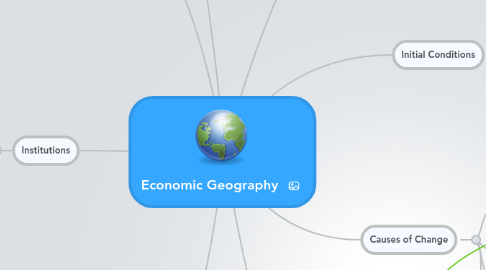
1. General World Model
1.1. Periphery
1.1.1. Core exploits periphery
1.1.1.1. Natural Resources Plundered
1.2. Core
1.2.1. Developed World
1.2.1.1. Exploit periphery
1.2.1.2. Small fraction of all countries
1.3. Between Core and Periphery
1.3.1. Developing Countries
1.3.2. Both the exploiters and exploitees
1.4. Benefits for using this model
1.4.1. Three tier structure
1.4.2. Simplifies world map
1.4.3. Explains why just a few countries are at the top
2. Institutions
2.1. State
2.1.1. Goals
2.1.1.1. Internal to State
2.1.1.1.1. Stability
2.1.1.1.2. Control
2.1.1.1.3. Revenue
2.1.1.2. External to State
2.1.1.2.1. World Influence
2.1.1.2.2. Protect National Interests
2.1.2. Actions (to meet goals)
2.1.2.1. Create Pro-Business Environment
2.1.2.1.1. Laws
2.1.2.1.2. Tax breaks
2.1.2.1.3. Special Economic Zones
2.1.2.1.4. Corruption (?)
2.1.2.2. State-Owned enterprises
2.1.2.3. Maximize Revenue (+GDP)
2.2. Transnational Corporations
2.2.1. Goals
2.2.1.1. Maximize Profits
2.2.1.1.1. Decrease Costs
2.2.1.1.2. Gain advantage over competitors
2.2.1.2. Minimize Costs
2.2.1.3. Retain Market Share/ Access
2.2.2. Actions (taken to meet goals)
2.2.2.1. Work with states
2.2.2.1.1. Leave hostile states
2.2.2.1.2. Stay in friendly states
2.2.2.1.3. Spread out across multiple states
2.2.2.1.4. Work with state to stifle competition
2.2.2.1.5. Lobbies (?)
2.2.2.2. Relocate to best location
2.2.2.2.1. Educated Work Force
2.2.2.2.2. Low Wages
3. Advantages to Using Economic Geography
3.1. Explains the role of geography in economic activity
3.2. New node
4. Name: Andrew Hardin
5. Physical Geography
5.1. Relative Location
5.1.1. Land Locked
5.1.2. Transnational Rivers
5.1.3. Many/ Few Neighbors
5.2. Absolute Location
5.2.1. Photosynthesis
5.2.2. Climate
5.3. Location Attributes
5.3.1. Resources (+/-)
5.3.2. Topology
5.3.3. Urban vs. Rural
5.3.3.1. Urban
5.3.3.1.1. Benefits
5.3.3.1.2. Drawbacks
5.3.3.2. Rural
5.3.3.2.1. Benefits
5.3.3.2.2. Drawbacks
6. Technological Change
6.1. How does it happen
6.1.1. Continuously
6.1.1.1. Occasional leaps forward
6.1.2. Life Cycle of new Tech
6.1.2.1. Initial Development
6.1.2.2. Growth
6.1.2.3. Maturity
6.1.2.4. Decline/ obscurity
6.1.2.5. New technological change
6.2. Effects
6.2.1. Decreases Costs
6.2.1.1. Transportation
6.2.1.2. Communication
6.2.1.3. Either clustering or dipersal
6.2.2. Narrow specialization
6.2.2.1. Clustered industries
6.2.3. Production changes
6.2.3.1. Flexible Production
6.2.3.2. Mass Production
6.2.3.3. Blue -> White collar jobs
7. Causes of Change
7.1. Environmental
7.1.1. Global Warming
7.1.2. Disasters
7.2. Innovation
7.2.1. Fueled by competition
7.3. Time
7.4. Failure/ Success
8. Initial Conditions
8.1. Physical Geography
8.2. History
8.2.1. Regional Significance
8.2.2. Industry Base
8.2.3. Path dependence
8.3. Significance
8.3.1. Explain why things are where they are
8.3.2. Comparative Advantage*
8.3.2.1. *Can change over time
